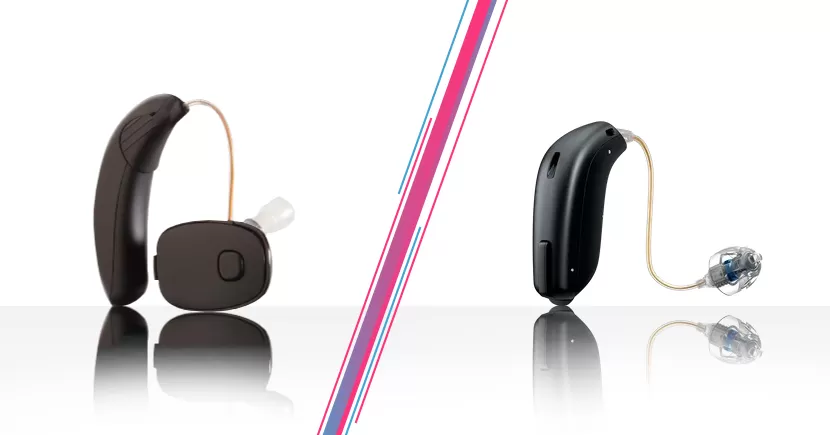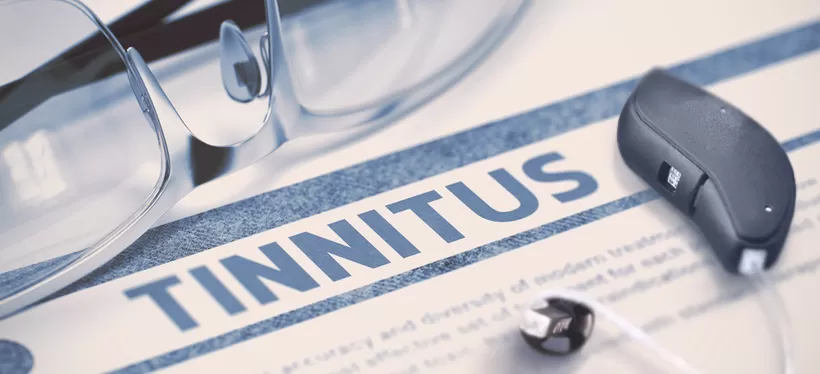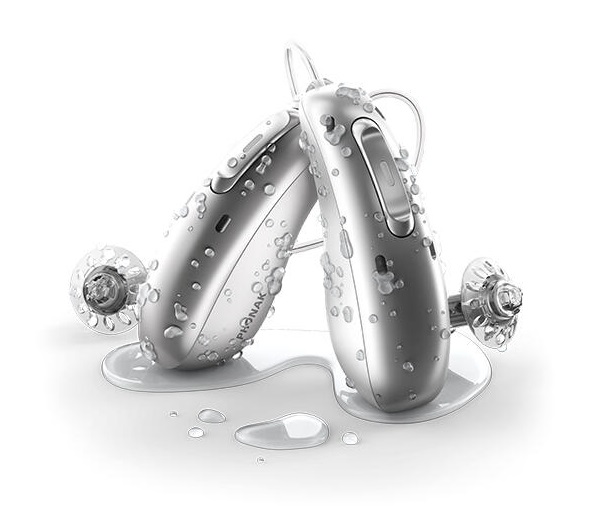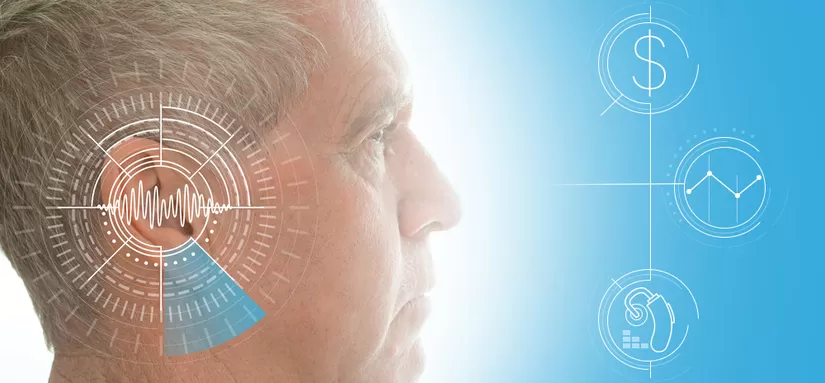ReSound Vivia: The World's Smallest —and only—AI-Powered Hearing Aid with Auracast Connectivity
Four years after the debut of the world’s first Deep Neural Network-powered hearing aid, GN ReSound has entered the ring with the Vivia—and in some ways, they’ve already outclassed competitors that have been refining their products for years.
Vivia is ReSound’s first hearing aid powered by a Deep Neural Network (DNN)—and the world’s first to fully support Auracast, rather than just being 'Auracast-ready' like its competitors. Despite its advanced technology, it’s no larger than its predecessor, Nexia, and boasts an impressive battery life of up to 20 hours—even with continuous Bluetooth streaming or extended use of the DNN-powered Intelligent Focus feature.

The headlines are impressive—Vivia has been trained on 13.5 million spoken sentences across 3.9 million tuned sound parameters, with its DNN performing a staggering 4.9 trillion operations per day to enhance speech and minimize background noise. ReSound is calling it the world’s smallest AI-powered hearing aid. But does it live up to the hype? In this deep dive, we’ll examine the claims and, after my experience wearing the ReSound Vivia, see how it performs, and how it stacks up against other DNN-powered hearing aids.
What’s new with ReSound Vivia
Vivia introduces a few impressive new features, but the standout feature is its deep neural network for sound processing.
Deep Neural Network-Powered ‘Intelligent Focus’
First, I want to be clear—these aren’t just AI buzzwords meant to make you pull out your wallet. AI is shaking up every industry, and in the last few years the hearing aid industry has figured out how to incorporate it into their devices. For hearing aids, it’s actually deep learning—a subset of AI—that’s providing the most notable improvements.
Traditional hearing aids have relied on directional microphones and fixed noise reduction strategies crafted by human engineers, and while they did a decent job in noisy environments, the benefits eventually hit a ceiling. That is, until deep neural networks (DNNs) came along.
How ReSound’s ‘Intelligent Focus’ feature works
ReSound Vivia still uses traditional approaches like directional microphones and noise reduction algorithms to filter and amplify sound—that all happens automatically in the background anytime you’re wearing Vivia hearing aids.
But sometimes, in noisy environments, that’s just not enough, and that’s where the Intelligent Focus feature and Vivia’s DNN kicks in. When in a challenging listening environment, the wearer can now activate this Intelligent Focus feature (manually, via the Smart 3D app or via the push button on the hearing aid), and next-level noise reduction and speech enhancement kicks in.
This tech is currently the holy grail of better hearing in noise, and here’s how it works.
First, think of the DNN as a smart, standalone software program—almost like a brain. Offline, this software is shown millions of sound samples by ReSound engineers, and it learns to identify certain patterns in the sounds. The engineers manually review the results, label them, and feed them back into the program so that the DNN continually learns and improves, much like a human brain. Once all the training is complete, the program is embedded onto a chip in the hearing aid, where it can be manually activated by you, the wearer, when you need that extra boost of speech clarity in noisy situations.
You can activate the DNN two ways: pressing the push-button on the hearing aid, or by selecting the Hear in Noise program in ReSound’s Smart 3D app. According to Resound, activating the DNN manually allows you to conserve battery life when you don't need the extra processing power. In other words, you rely on the baseline methods during normal use, and then turn on Intelligent Focus when you know you'll benefit from that additional layer of advanced, real-time sound filtering.
‘Intelligent Focus’ is essentially ReSound’s branded implementation of their DNN-powered enhancements.When you hear about Intelligent Focus, it’s referring to the system that leverages the DNN’s capabilities to automatically zero in on speech—especially in challenging, noisy environments—ensuring that conversations are heard clearly while background noise is minimized.
Right now, the Intelligent Focus feature is only available in the ‘9’ technology level in the microRIE style. This means we expect the rechargeable Vivia 9 microRIE model to be the most popular, as it combines a compact design, convenience (no disposable batteries needed), and excellent performance in noisy environments.
ReSound Vivia’s Auracast is Activated
Auracast is one of those game-changing features you might not have heard of yet, but it’s poised to benefit everyone—not just hearing aid wearers. Auracast is a Bluetooth LE Audio feature that lets you wirelessly stream audio from a broadcaster to compatible devices like hearing aids, earbuds, or headphones.
Imagine you’re at an airport, getting announcements from their broadcast system streamed directly into your hearing aids, so you never miss an update. Or you’re at a theatre, getting the audio streamed directly into your hearing aids so you feel like you have the best seats in the house. Auracast lets you effortlessly tune in to audio sources like these without extra devices.
Auracast works as a three-part system. First, an Auracast transmitter (like a TV or smartphone) broadcasts the audio stream; next, the Auracast Assistant (in this case your phone with the ReSound Smart 3D app) helps you find and connect to the audio stream (just like you’d connect to a WiFi network); and finally, an Auracast receiver—in this case your ReSound Vivia hearing aid—picks up the stream, allowing you to listen in. This system enables seamless wireless audio streaming in public spaces.
ReSound is leading the industry by actually activating Auracast in their Vivia devices, while competitors are still stuck with “Auracast-ready” models that are promised to be activated ‘sometime in the not too distant future.’
That said, the technology is still in its early days—there are only a handful of Auracast broadcasters out there, meaning that while you have the tech in your hearing aids now, widespread real-world use will take a few years to catch on. When it does, Auracast may revolutionize not only personal hearing but public audio experiences for everyone.
New Microphone Filters
All Vivia hearing aids come equipped with new microphone filters that enhance durability by preventing debris buildup while allowing for easy at-home or in-clinic replacement—no need to send them back to ReSound for maintenance. Each of the two microphones on the back of the aids is protected by a filter, which can be swapped out using the microphone filter tools provided by your hearing care professional.

There’s no set guideline on how often to replace these filters—it should simply be part of your regular troubleshooting if performance declines. If your hearing aid isn’t working like it should, swapping out these new filters could definitely do the trick.
Examining the Claims
ReSound’s press releases highlight four main claims. As with every new release, we compared these claims against the supporting studies provided by ReSound. First, we commend the company for making these studies available—a level of transparency we believe every manufacturer should embrace when launching a new product (though not all do).
Claim #1: Vivia is the world's smallest AI powered hearing aid.
We measured and weighed Vivia against the 4 other AI-powered hearing aids on the market, and Vivia is indeed the smallest of the bunch (by volume). The next closest contender is Starkey Edge AI which actually weighs a bit less than Vivia, but Vivia overall is still smaller.

Claim #2: This DNN-powered solution is up to 17 times more efficient than other leading hearing solutions with directionality and DNN noise reduction, resulting in a significant improvement to speech understanding.
This claim is about computational efficiency. It doesn’t mean you’ll hear 17 times better or get 17 times better battery life. Instead, it highlights how ReSound Vivia’s AI-powered noise reduction achieves comparable performance with 17 times fewer processing nodes than one leading (unnamed) competitor tested in ReSound’s study, making it more power-efficient without sacrificing clarity. This efficiency is likely why Vivia’s battery life is among the best in its class, drastically outperforming some competitors that use more power-hungry AI systems.
This stat highlights node count as a key measure of efficiency, but DNN performance depends on more than just that. Different manufacturers optimize their AI systems based on their own design philosophies—some may use more nodes to take a different approach to noise reduction, while ReSound has prioritized power savings and size.
Claim #3: 83% of users experience better hearing in noise with Clear Focus.
If you’re considering the Vivio microRIE 9 model with DNN-based noise reduction (and you should be), this claim doesn’t apply to you—skip to Claim #4. The Intelligent Focus feature, which uses DNN-based noise reduction, is only available in the microRIE (rechargeable) model. The disposable battery models use a different non-DNN noise reduction system called Clear Focus—and that’s the focus of this claim.
According to the ReSound’s study, 15 out of 18 hearing aid users (83%) demonstrated improved speech recognition in noise with Clear Focus compared to a competing premium hearing aid using a different directional technology.

It's important to note that this improvement was measured against one unnamed competitor’s premium device and that the sample size is relatively small. However, these factors are not uncommon in these types of studies, and the results remain a valid indicator of Clear Focus’s effectiveness.
Claim #4: Studies show ReSound Vivia offers the world's best hearing in noise experience, with 64% of users experiencing improved hearing in noisy environments compared to other AI hearing solutions, so they can enjoy conversations with greater ease and understanding.
While Vivia does perform well in noise—and in some instances even outshines competitors as I mention below in my review—I wouldn't go so far as to label any DNN-based hearing aid “the best” based on my experience with various devices (I’ve worn them all).
The study backing the 64% figure involved a small sample (14 users) and appears to have compared Vivia against just one other brand, like claim #3. There may be more research forthcoming, but for now, I consider claim #4 a bit broader than the specific findings in the study.
ReSound Vivia Expert Review
How Vivia Looks, Fits, and Feels on the Ear
Dimensions (L x W x D): 26.9mm x 7.5mm x 11.2mm
Weight: 2.42g
ReSound Vivia fits as comfortably as any hearing aid I’ve ever worn, and sits just as discreetly behind the ear. Within a minute of putting on this hearing aid I would completely forget that I was wearing it. You really can’t feel it at all, and from straight on you can’t see it at all unless you’re really trying. You can see it a bit from behind and the side, but if you get a color that matches your hair better than this matches mine (shown below), it’ll go a long way towards making it more discreet.

ReSound was kind enough to send me this hearing aid for testing before the official launch, so colors were limited. If I were to buy these for myself I would get them in the espresso color, to better match my hair.
The hearing aid was simple to put in, I didn’t have to contort it at all like I’ve had to with other brands to get it to fit perfectly. Some of this will depend on your individual ear anatomy, but for my ears, they just slid right into the perfect position and stayed sitting securely all day long—I never felt like they were moving out of place or dangling loosely.
Performance in noise
I’ve now worn all 4 of the hearing aids on the market that use a deep neural network for speech enhancement and noise reduction, and they have all blown my mind.
What I found Vivia particularly good at, and perhaps best in class, was ambient noise reduction. At a noisy restaurant, when turning on the Hear in Noise program (the one that uses the DNN chip), the chatter from all around the restaurant gets drastically lower so you can hear people at your table clearly.
Switching between programs
Most hearing providers will set up your hearing aids similarly to how I configured mine, allowing you to easily switch between programs and hear the difference firsthand.
ReSound offers two primary programs:
General/All Around: Best for everyday environments.
Hear in Noise: Utilizes the DNN chip for enhanced speech clarity in noisy settings.
In my day-to-day use, I kept the hearing aids on the General/All Around program. But when I found myself in louder environments, I’d switch to the Hear in Noise program—either by pressing the button on the hearing aid or using the app. Personally, I preferred the simplicity of using the physical button over the app.

The difference between the Hear in Noise program and the General/All Around program is astonishing, and I actually preferred the Hear in Noise program over the All Around program in all environments.
This isn’t the first time I’ve preferred a manufacturer’s DNN program compared to all their other programs, but it is the first time a manufacturer has allowed me to set up the hearing aids so that is the default program that is selected when I turn on the hearing aids—a feature I love.
For me, this is the ideal setup, because if I were going to wear these, I’d only use them in the noisiest environments, so I’d want that DNN to be activated anytime I put the hearing aids on. But for most people, that’s not going to be a practical setup, because using the DNN full time will drain the battery quicker than you might like, as I discuss below in the battery life section.
Bluetooth Connectivity and Streaming Sound Quality
ReSound Vivia, like all major prescription hearing aids, are Bluetooth compatible. This feature allows you to stream phone calls, music, podcasts and other audio directly from smartphones, computers, TVs, and more—similar to how you’d use wireless earbuds.
Pairing with iPhone
Connecting Vivia hearing aids to an iPhone is straightforward, though slightly different from pairing typical Bluetooth devices. (For reference, I used an iPhone 13 Pro Max during testing.)

Once paired through the iPhone’s native Bluetooth interface, you can stream any audio—calls, music, audiobooks—just like you would with AirPods. If you’d like more control over settings, the ReSound Smart 3D app offers additional functionality.
Pairing with Android
Android users typically need the ReSound Smart 3D app to connect. Unlike iPhones, most Android devices don’t pair directly through the phone’s native Bluetooth settings. Using the app allows you to stream audio and adjust hearing aid settings seamlessly.
Streaming Sound Quality
The streaming sound quality isn’t very good, and it’s not very good with any hearing aids. The sound is not well-rounded, there’s a lot of treble, and hardly any bass.You will prefer using standalone headphones. I found the hearing aids tolerable for streaming content like podcasts and audiobooks, where sound quality isn’t as important.
The good news is, ReSound Vivia supports Bluetooth LE Audio, which is supposed to improve streaming quality. The bad news is, few phones currently support Bluetooth LE Audio. Like Auracast, this is one of those features that is great to have in Vivia hearing aids, because it makes the hearing aids future-proof, but it’s not a feature most people will benefit from immediately.
Understanding Bluetooth Protocols
ReSound Vivia supports three Bluetooth standards:
Bluetooth LE Audio: The newest Bluetooth standard, designed to offer improved sound quality, lower power consumption, and enhanced features like Auracast™. If your phone has this version of Bluetooth (few do), this is the ideal way to connect to Vivia devices.
Made for iPhone (MFi): Apple’s proprietary Bluetooth protocol allows for direct streaming of calls, music, and notifications from iPhones, iPads, and Macs without the need for an additional app. ReSound actually pioneered this protocol in collaboration with Apple back in 2014.
Android Audio Streaming for Hearing Aids (ASHA): Developed by Google, ASHA enables direct audio streaming from compatible Android devices to hearing aids. Unlike MFi, ASHA (usually, not always) requires pairing through the manufacturer’s app—in this case, the ReSound Smart 3D app—to connect and manage settings.
Your phone’s Bluetooth version determines which protocol it uses—which determines which features and functionality you will have access to. For example, my iPhone 13 Pro Max defaults to MFi since it lacks Bluetooth LE Audio support.
Since my iPhone “falls back” to MFi, that means I don’t get the benefits of Bluetooth LE Audio, like improved streaming sound quality or Auracast.
Another example of this disparity in functionality is with phone calls. With my iPhone, I can simply tap a button on the hearing aid to accept a call and talk hands-free. This is not the case with Android devices, you’d need to purchase the intermediary streaming device, the Phone Clip + (shown below on this page).
In short, all smartphones can pair with Vivia hearing aids via Bluetooth for audio streaming, with the option to control settings through the Smart 3D app. What’s going to vary from phone to phone is how phone calls are handled, and the streaming sound quality of the audio. To get a sense of which features/functionality you will be able to take advantage of, review ReSound’s device compatibility page.
Phone calls through Vivia hearing aids
This is a pretty slick feature that will work with many iPhones (again check that compatibility list above to make sure yours is compatible). When a phone call comes in, you can tap the push button on the hearing aid and just start talking (hands free). The microphones on the hearing aids pick up your voice so you don’t have to hold the phone to your face like you normally would.
ReSound also has a feature called ‘TapControl’ where you can air tap your ear to answer calls. It’s cool when it works, but it didn't work reliably enough for me to enable this feature and I would recommend you keep it turned off (your hearing provider can do that for you). I found that it worked maybe half of the time, which is just annoying, especially when tapping the push button is simple and works every time. Another reason I turned off TapControl is I accidentally answered a spam call when I was simply adjusting the hearing aid.
Battery Life
The official word from ReSound is that the Vivia microRIE will last 30 hours on a single charge—assuming you don’t use Intelligent Focus (the DNN chip), or Bluetooth streaming. ReSound also says that their user insights show that 2 hours of streaming a day, and 3 hours of using the DNN chip is what they consider “typical usage,” and that under those circumstances, battery life will be 20 hours.

I tested battery life 3 ways, and here’s the lifespan I got—
Wearing only in my quiet office (no streaming, do DNN use): 40 hours
Wearing everywhere, 2 hours of streaming, 3 hours of DNN use: 24 hours
Wearing using the DNN chip exclusively, no streaming: 12 hours
I don’t think you’re going to have any complaints with the battery life, especially if you remember to charge it nightly. It looks like ReSound may be under promising and over delivering a bit on their battery life, but then again by year 3 or 4 that battery life won’t be as good as it is now, as lithium-ion batteries do degrade over time.
How Vivia’s battery life stacks up to competitors
On the far end of the spectrum, the Starkey Edge AI offers up to 51 hours of battery life (even with the DNN being used constantly). On the other end, the Phonak Audeo Sphere Infinio can last as little as 7 hours if the DNN is used constantly, but with normal use it’d last around 16 hours. ReSound Vivia falls right around the middle, next to Oticon Intent, with around 20 hours daily assuming a few hours of DNN use, and a few hours of Bluetooth streaming.
General Observations
Ease of use
I generally don’t like to use the apps very much when I test drive hearing aids, because I don’t think that I’d use them that much in real life. Usually, when I wear small hearing aids like this that only have a single push-button, I’m left wishing I had more control over the hearing aid (without needing to go into the app). That wasn’t the case with Vivia, I always felt like I could do everything I needed, with that single push button. Whether it’s adjusting the volume, program, answering calls, or turning the hearing aids off—everything I needed to do, I could do via the button alone without needing to open the app.
Circuit noise
All hearing aids have this noise, it’s a very soft white noise that is generated from the device’s circuitry. My hearing is exceptional in the low frequencies, so I always hear this in all hearing aids—you may not. ReSound Vivia was about average in regards to how ‘quiet’ (how minimal) the circuit noise was. In my experience Starkey Edge AI is the quietest aid on the market, and Vivia is right around the same amount of circuit noise as the rest of the competition.
Wind noise reduction
This is an important feature if you live in an area with lots of wind, and if you do outside activities that require conversing with others—walks, golfing, pickleball, etc. When wind hits the microphones of hearing aids (any hearing aids), it makes a scratchy noise that can interfere with the speech you’re trying to hear, and even if you’re not trying to hear speech, it can just be annoying to hear a harsh scratchy/crackling sound through the hearing aids when it’s windy.
In the General/All Around program, wind noise reduction works as well as any of the competitor hearing aids I’ve tested. In the Hear in Noise program, wind noise reduction is the worst of any hearing aid I’ve tried recently. It wouldn’t take much wind at all, just a light breeze when on a casual walk, to make some pretty bothersome sounds through the hearing aids.
However, while not ideal, I think it’s okay, because you’d typically only use the Hear in Noise program at a noisy (indoor) restaurant, convention, etc, where wind would likely not be a factor.
ReSound Vivia Pros & Cons
Pros
Size: Despite adding a second chip to the hearing aid to power the DNN, ReSound Vivia is still the smallest AI-powered hearing aid in the world. When you compare it to the Phonak Audeo Sphere (a leading competitor’s AI-powered hearing aid), Vivia is 84% smaller in volume and 40% lighter in weight.
Auracast Activated: Vivia is the first hearing aid to actually have Auracast activated. Every competitor product is shipped with ‘Auracast-ready’ (meaning it’s not activated), and in order to use it, folks will have to visit their hearing provider in the future for a firmware update to the hearing aids—an inconvenience for customers and hearing providers alike. Note that Auracast is still in its very early days, so you’re not going to actually benefit from this tech yet, but it’s nice to know you have it in Vivia hearing aids, and that makes them more future-proof.
The Hear in Noise program (DNN chip) works very well. The ability of this program to immediately reduce all competing noise is astounding and a huge improvement compared to using just the All Around program by itself. If you’re like me, you might just wish this Hear in Noise program was always activated.
Cons
The DNN isn’t always on: To be fair, some would call this an advantage as it preserves battery life. But in a perfect world, a user shouldn’t have to manually activate any feature on their hearing aids—it should happen automatically. I would’ve loved if the hearing aids were able to auto-switch in and out of the Hear in Noise program and I think it’d make the user experience more effortless, but I also understand that can have some unexpected downsides.
The DNN chip is only available in the microRIE style, and the ‘9’ tech level: If you prefer disposable batteries, you can buy the Vivia in the 13 or 312 model, but it won’t have all this new DNN tech. We asked ReSound about this, and their response was that the DNN chip needs the constant, consistent power of the rechargeable battery to operate fully, and relying on the power and variability of replacement batteries is not optimal for DNN chip performance. In addition, this tech is only available in the premium ‘9’ tech level, so it’s going to be financially inaccessible for some people.
Conclusion
After what seems like a decade of incremental improvements in hearing aid tech, competition is suddenly heating up dramatically. With each new hearing aid release, I’m seeing more ‘shots fired’ by all manufacturers.
ReSound says there's “no compromise” with Vivia—a dig at Phonak who in late 2024 released a (quite large) DNN-powered hearing aid, with in some cases very minimal battery life. Oticon advertisements have suddenly been circling the web focusing on the fact that their DNN is ‘always on.’
It’s clear that different manufacturers have different engineering, design, and UX philosophies, and they're all making bets about what is going to resonate in the market. The manufacturers are going to battle this out, and you, the consumer, are going to win.
As for me, I think ReSound has a winner on its hands, and Vivia is obviously leaps and bounds better than any hearing aid they’ve ever put out. It’s as small as any hearing aid they’ve ever released, the battery life is just as good, it’s future-proofed with Bluetooth LE Audio and Auracast, and it uses the gold standard of deep learning to help wearers hear their best in noise. There really isn’t much ReSound could’ve done here to put a better foot forward.


















->getDescriptorURL()?>)










































![Buying Hearing Aids Online [Pros & Cons, Tips] Preview for the "Buying Hearing Aids Online [Pros & Cons, Tips]" video](https://cdn.ziphearing.com/dist/dynamic/files/videos/8/thumbnail/version/1/100/thumbnail.jpg)

![Rechargeable Hearing Aids [Pros & Cons] Preview for the "Rechargeable Hearing Aids [Pros & Cons] " video](https://cdn.ziphearing.com/dist/dynamic/files/videos/20/thumbnail/version/1/100/thumbnail.jpg)























